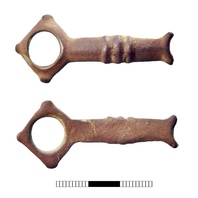
Viking Objects
Harness Fitting (SUR-38C283)
A simple double ended strap-link used as part of a harness. The metal has a reddish tint often associated with Anglo-Scandinavian material.
Read More
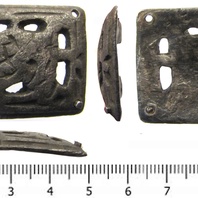
Viking Objects
Anglo-Scandinavian Silver Mount (SWYOR-0201A1)
This silver rectangular mount is decorated with an openwork design consisting of a possible backward-facing animal alongside interlace which may have zoomorphic elements.
Read More
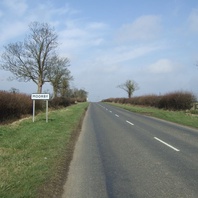
Viking Names
Moorby
The first element of Moorby, in the Horncastle Wapentake of Lincolnshire, is either Old English mor or Old Norse mór ‘a marsh; barren upland’ here in the sense ‘moor’. The second element is Old Norse bý ‘a farmstead, a village’. The village is on the slope of the Wolds.
Read More

Viking Names
Wigtoft
Wigtoft, in the Kirton (in Holland) Wapentake of Lincolnshire, is likely an Anglo-Scandinavian compound. The first element is uncertain, but it is probably Old Norse vík ‘a small creek, an inlet, a bay’. The second element is Old English toft ‘a curtilage, the plot of ground in which a dwelling stands’. Wigtoft is situated near Bicker Haven, which was formerly an arm of the sea.
Read More
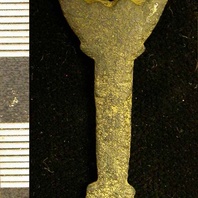
Viking Objects
Copper-Alloy Key (LEIC-931912)
Slide keys such as this example are generally known as ‘Viking keys’ due to similarities in shape with excavated examples. However, its T-shaped projections at the base have no identified parallels but the design could possibly show Anglo-Scandinavian influence. Keys were not only practical items but also symbols of status. Women often carried the keys to the family’s chests of valuables. They also are often buried with keys, representing their authority in the household. See also the blog post on keys in the Viking Age.
Read More
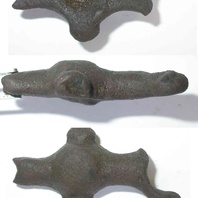
Item
Bridle Fitting (DENO-58B097)
This fragment of cast copper-alloy bridle fitting has a central, sub-circular boss with concave indent to the reverse side. The concave shape of the broken ends of the bars indicate that this fitting originally had a loop at either end.
Read More
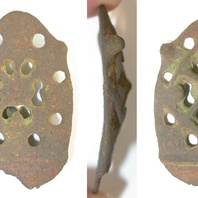
Viking Objects
Copper-Alloy Strap-End (DENO-083C15)
This copper-alloy strap-end, classified as Thomas Class E, is decorated with a central openwork lozenge with two perforations within each quarter surrounded by eight circular perforations. Strap ends came in various styles and were fairly common throughout the Viking world. They were used to decorate the ends of belts and to stop them getting damaged.
Read More
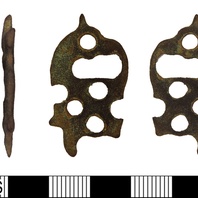
Viking Objects
Urnes-Style Strap-End (LEIC-B46A41)
This fragmentary copper-alloy strap-end is decorated with openwork zoomorphic design in the Urnes style. It has been classified as a Thomas Class G strap-end.
Read More
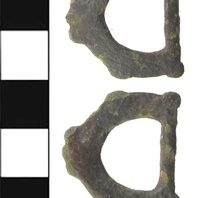
Viking Objects
Ringerike Buckle (SWYOR-22FFC7)
This cast copper-alloy buckle has some elements of the Ringerike style decorating a broad, flat frame and a narrowed strap bar.
Read More

Viking Names
Normanton
Normanton, in the Repton and Gresley Hundred in Derbyshire, takes its name from the Old English ethnonym Norðman ‘Northman, Norwegian’ and the Old English element tun ‘farm, settlement’. There are several places of this name, predominantly in the East Midlands: five in Nottinghamshire, and some in Derbyshire, Leicestershire, Lincolnshire and Rutland, and one in the West Riding of Yorkshire. Traditionally, the place-name has been interpreted as referring to a settlement of Norwegians (in an area where most of the Scandinavian settlers were Danes). However, the exact implications of such a name are not yet fully understood and are the subject of ongoing work by Dr Jayne Carroll of the Institute for Name-Studies, University of Nottingham.
Read More
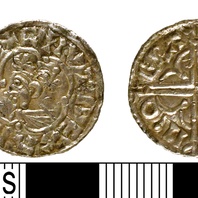
Viking Objects
Coin of Cnut the Great (NARC-5DBF29)
This silver penny was minted in Cambridge for King Cnut the Great, the Danish king who reigned over England from 1016-1035. This particualr coin is is classified as a quatrefoil obverse type. Minting coins was a way of controlling the means of exchange within a kingdom and which created a more easily administered standardized system of trade. Moreover, the coins themselves were often used as propaganda, portaying symbols and statements that gave off a desired message. The Vikings later used the minting of coins to legitimize their own rule.
